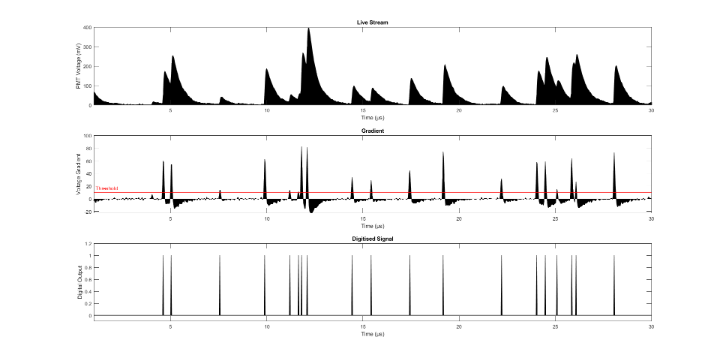Pulse Readout
In the scanning transmission electron microscope (STEM), typical detectors employ a scintillator and photomultiplier system to measure the impinging electrons. This detection method results in several undesirable effects, especially for quantitative measurements: Inhomogenous detector response, signal streaking from unwanted detector afterglow and excessive dark noise. The result is that each individual electron is detected differently and image contrast cannot be easily interpreted quantitatively. To solve this, we have created the Digital pulse readout system to perform individial electron detection on your existing scintillator-based detector. The concept and methodology was demonstrated in our paper: Mullarkey et al. in Microscopy and Microanalysis (doi: 10.1017/S1431927620024721) and was awarded the journal front cover image (shown on the right).
A key advantage of our pulse readout is the use of the gradient of the signal from the detectors photomultiplier tube (shown below). Because of this, ourpulse readout can distinguish rapid electron events (known as pile-up) that would overwhelm a simple threshholding approach. Our approach therefore retains high efficiency even at relatively high electron dose as well as achieving a higher dynamic range.
Original development of pulse readout was performed using a USB oscilliscope attached to the STEM detector output. Images had to be formed after the experiment and working conditions were a bit cramped next to the control electronics!
To improve usability of the pulse readout, an FPGA solution was developed using a Red Pitaya with custom designed electronics. By plugging directly in to a Gatan Digiscan as a detector, images can captured as easily as with any other detector, just press acquire!
Initial prototypes worked well, but were too bulky to be left in place. The current version of the hardware uses a custom designed PCB to form a small, yet powerful package that performs pulse counting on up to two detectors. It can be controlled directly through software integrated into DigitalMicrograph and requires very little setup!


/prod01/channel_3/media/tcd/physics/research-groups/ultramicroscopy/images/banners/det.png)